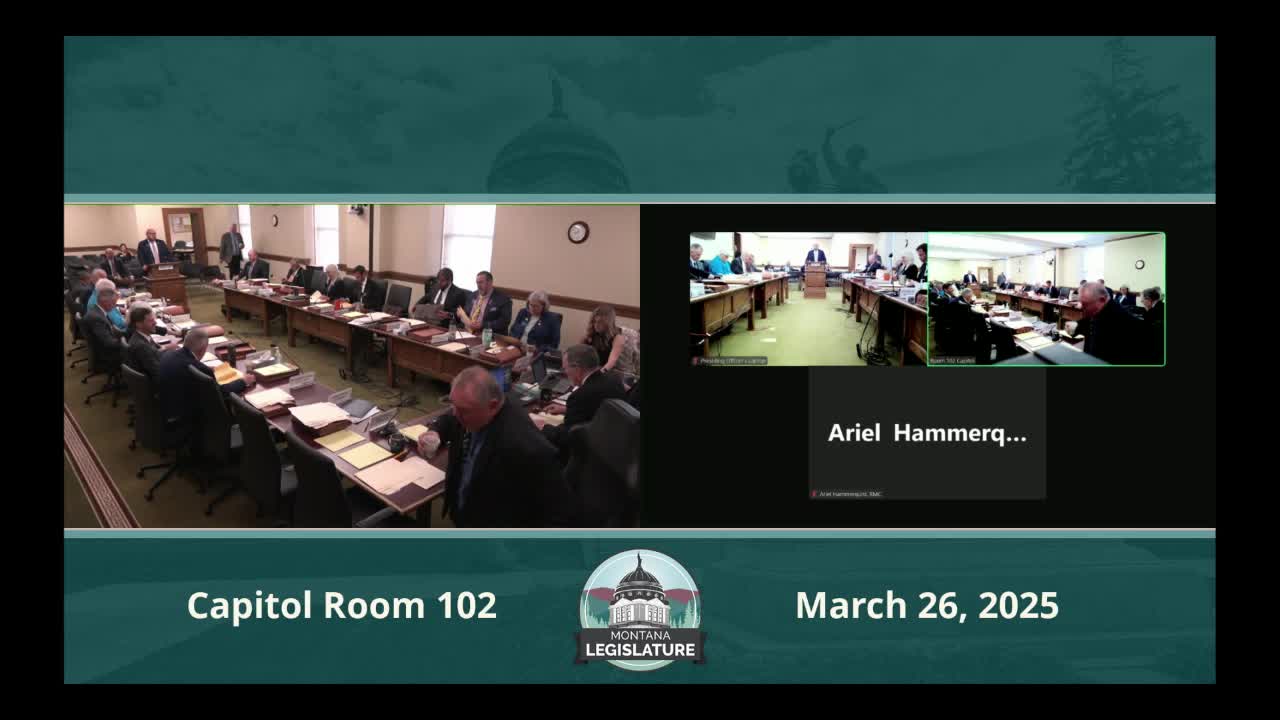Committee hears bill to raise MFFA bonding cap, sponsor urges ‘due pass’
March 26, 2025 | 2025 Legislature MT, Montana
This article was created by AI summarizing key points discussed. AI makes mistakes, so for full details and context, please refer to the video of the full meeting. Please report any errors so we can fix them. Report an error »

Representative Schomer, sponsor of Senate Bill 104, told the Appropriations Committee that the bill would raise the statutory cap on the facility finance authority’s conduit bond program to allow larger projects and more issuances. “This bill increases the revenues for MFFA which can cover any increases in costs and creates revenue for the general fund,” Schomer said.
The hearing featured testimony from Adam Gill, representing the facility finance authority (MFFA). Gill described the authority as a conduit that connects borrowers with lenders and said expanding the cap would let the authority facilitate larger projects for hospitals, schools, museums, businesses and certain large private projects. “By giving us that room, it allows us to do more bonds of different types and raises our caps so we can do larger projects,” Gill said.
Gill said the MFFA is an enterprise fund attached to the Montana Department of Commerce, supported by fees and reserves, and that the authority has been profitable in recent years. He told committee members the state levies a statutory charge of 3 basis points on every new issuance (about $0.30 per $1,000 issued) that flows to the general fund under MCA 17-5-2201. He described the fiscal projections in the bill’s fiscal note as market-dependent and not guaranteed.
Committee members asked about credit quality, borrower default history and program demand. Gill said that in roughly 40 years and about $4 billion of conduit issuances the authority had not experienced a borrower default, and that no current borrowers are more than 30 days delinquent “to our knowledge.” He described the program’s market niche: tax-exempt conduit financing becomes attractive for large nonprofit or qualifying projects where the tax benefit can meaningfully lower rates, and conduit financing can provide access to capital markets that small or rural local governments would otherwise not reach.
Gill described recent activity levels and the statutory cap’s history: the statute established limits decades ago, was $250 million when enacted in 1983 and was raised to $500 million in 2007; Gill said MFFA issued roughly $380 million of new money in 2022 and had about $1.2 billion of projects in its pipeline that could be staged across biennia. He told the committee, “We need to raise that cap.”
On fiscal impact, Gill said the fiscal note projects a return to the general fund (he cited a projected figure for the first year in the fiscal note) but emphasized the projection’s sensitivity to market conditions. Committee members asked for the MFFA’s most recent annual report; Gill agreed to send recent reports to the committee.
Representative Schomer closed the hearing by urging a “do pass.” The committee recorded no final vote in the hearing record; the bill’s next steps were not decided in the hearing.
Ending: The committee closed the SB 104 hearing without recording a committee vote and proceeded to the next item on the agenda.
The hearing featured testimony from Adam Gill, representing the facility finance authority (MFFA). Gill described the authority as a conduit that connects borrowers with lenders and said expanding the cap would let the authority facilitate larger projects for hospitals, schools, museums, businesses and certain large private projects. “By giving us that room, it allows us to do more bonds of different types and raises our caps so we can do larger projects,” Gill said.
Gill said the MFFA is an enterprise fund attached to the Montana Department of Commerce, supported by fees and reserves, and that the authority has been profitable in recent years. He told committee members the state levies a statutory charge of 3 basis points on every new issuance (about $0.30 per $1,000 issued) that flows to the general fund under MCA 17-5-2201. He described the fiscal projections in the bill’s fiscal note as market-dependent and not guaranteed.
Committee members asked about credit quality, borrower default history and program demand. Gill said that in roughly 40 years and about $4 billion of conduit issuances the authority had not experienced a borrower default, and that no current borrowers are more than 30 days delinquent “to our knowledge.” He described the program’s market niche: tax-exempt conduit financing becomes attractive for large nonprofit or qualifying projects where the tax benefit can meaningfully lower rates, and conduit financing can provide access to capital markets that small or rural local governments would otherwise not reach.
Gill described recent activity levels and the statutory cap’s history: the statute established limits decades ago, was $250 million when enacted in 1983 and was raised to $500 million in 2007; Gill said MFFA issued roughly $380 million of new money in 2022 and had about $1.2 billion of projects in its pipeline that could be staged across biennia. He told the committee, “We need to raise that cap.”
On fiscal impact, Gill said the fiscal note projects a return to the general fund (he cited a projected figure for the first year in the fiscal note) but emphasized the projection’s sensitivity to market conditions. Committee members asked for the MFFA’s most recent annual report; Gill agreed to send recent reports to the committee.
Representative Schomer closed the hearing by urging a “do pass.” The committee recorded no final vote in the hearing record; the bill’s next steps were not decided in the hearing.
Ending: The committee closed the SB 104 hearing without recording a committee vote and proceeded to the next item on the agenda.
View full meeting
This article is based on a recent meeting—watch the full video and explore the complete transcript for deeper insights into the discussion.
View full meeting
